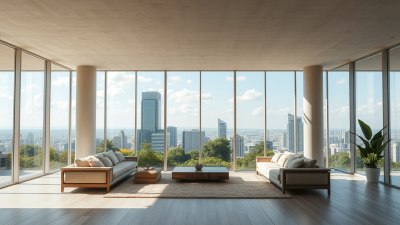Happiness Found in Open Air and Open Plans
Explore the connection between open air living and happiness through design and nature.

Image created with Flux Schnell
In today's fast-paced world, the pursuit of happiness is a common theme that resonates across cultures and societies. Growing numbers of studies are revealing the profound impact that our environment has on our psychological well-being. One of the emerging concepts that intrigue architects, urban planners, and mental health professionals alike is the idea of open air living and open plans. This revolutionary approach to both architectural design and urban living focuses on creating spaces that foster connection, freedom, and a deeper appreciation for nature.
Open air environments, often characterized by natural ventilation, abundant light, and proximity to nature, enable individuals to experience a range of psychological benefits. The vastness of open spaces, whether in exterior parks or within expansive homes, offers a welcome respite from the constrictions of urban life. An increasing body of research underscores the relationship between natural settings and mental well-being, suggesting that time spent outdoors can significantly reduce feelings of anxiety, depression, and stress.
The Neuroscience of Nature
Understanding our connection to nature involves delving into the science of how our brains respond to the natural world. Neurobiologists have discovered that exposure to natural environments can lead to the release of dopamine—a neurotransmitter that plays a key role in feelings of pleasure and happiness. When we step outside into the fresh air, surrounded by greenery, we experience a shift not only in our mood but also in our cognitive abilities. Studies show that individuals who spend time in natural settings perform better on tasks that require attention, creativity, and problem-solving skills.
Furthermore, biophilic design—a term that describes the incorporation of natural elements into building design—has gained popularity as a way to enhance the psychological benefits of our surroundings. By using materials that reflect nature, allowing natural light to flood living spaces, and incorporating views of greenery and water, architects can help to create a seamless blend between the indoors and the outdoors, promoting overall well-being.
The Role of Open Plans
Open plan living, a design trend that eliminates traditional barriers between rooms, has transformed the way people experience their home environments. This type of layout encourages social interaction and communal living, breaking down the isolation that enclosed spaces can create. By fostering a sense of connection, open plans support not just the individuals who live in a space but also enhance family dynamics and friendships.
With fewer walls, open plan homes tend to feel more spacious and inviting. The flow of natural light is maximized, and air circulation improves, contributing to a healthier living atmosphere. Additionally, the flexibility offered by open spaces allows homeowners to customize their environments easily to suit their evolving needs. With the rise of remote work and changes in lifestyle due to the pandemic, many have found that having versatile, open spaces enhances productivity and satisfaction.
Connection to Outdoor Spaces
Integrating open air living into our daily routines lies at the heart of truly embracing happiness. Outdoor spaces have the potential to redefine our interactions with the world around us. Balconies, terraces, gardens, and parks provide opportunities for relaxation and rejuvenation. They serve as essential retreat spaces for individuals, families, and communities alike.
Outdoor activities and physical engagement with nature can significantly impact well-being. Whether it's a morning coffee enjoyed in the gentle glow of sunrise on a terrace, family gatherings in a garden, or playing with pets in a park, outdoor spaces foster moments of joy and connection. The simple act of stepping outside can ignite feelings of gratitude and contentment, reminding us of the beauty and possibilities life has to offer.
Community and Social Interaction
Open air living not only promotes individual happiness but also contributes to building stronger communities. Spaces designed for community interaction, such as public parks, plazas, and outdoor recreational areas, help to bridge social gaps. When people come together outdoors, their interactions tend to be more relaxed and organic compared to formal settings, promoting a sense of belonging and community engagement.
As urban planners and city officials strive to create inclusive public spaces, they are increasingly recognizing the importance of open-air environments. Differently designed areas—such as interactive gardens, thematic parks, and open-air markets—can attract individuals from varied backgrounds, encouraging multicultural exchange and dialogue. The act of gathering in open spaces nurtures community spirit, enhances social ties, and fosters mutual support.
The Impact of Nature on Mental Health
The concept of nature therapy, which emphasizes the healing properties of natural environments, has gained traction in recent years. As mental health awareness continues to rise, clinicians and therapists are advocating for integrating nature exposure in therapeutic practices. This approach aligns well with the principles of open air living and open plans, as spending time in green spaces has proved effective in alleviating symptoms of anxiety, PTSD, and other emotional disturbances.
Research findings supporting the efficacy of nature on mental wellness stem from various studies that reveal a connection between forest bathing, horticultural therapy, and mindfulness practices conducted in outdoor settings. The calming presence of nature—be it in the form of plants, water features, or scenic views—can reduce the body's stress response and promote relaxation. Implementing these insights into urban design can lead to happier, healthier individuals, contributing to the overall well-being of communities.
Designing for Happiness
The philosophy behind creating open-air environments hinges on the multidisciplinary approach that combines insights from psychology, architecture, and ecology. Architects and city planners are encouraged to leverage sustainable materials and techniques that enhance energy efficiency while maintaining the connection to the outside world. Moreover, incorporating green roofs, vertical gardens, and natural ventilation systems into buildings emphasizes the importance of creating spaces that promote harmony with nature.
Furthermore, the integration of technology within open plans opens up new possibilities for happiness-enhancing features. Smart homes equipped with systems to optimize sunlight exposure, monitor air quality, and create dynamic environments based on residents' needs can further enrich the experience of open air living. Ultimately, designing for happiness requires a forward-thinking mindset that values both functionality and emotional resonance.
The Future of Urban Living
As cities continue to grow, prioritizing open air environments and open plans will be essential in shaping the future of urban living. Forward-thinking municipalities are beginning to acknowledge the necessity of bringing nature back into the urban landscape. This involves not just creating parks and green spaces but also considering how residential and commercial buildings interact with their environments.
Changes in lifestyle patterns - such as remote work and increasing time spent in our homes—embolden us to embrace environments that prioritize happiness, health, and well-being. The lessons learned from the open air living movement can guide architects, urban planners, and policymakers in rethinking how our spaces are designed and utilized.
In conclusion, the pursuit of happiness can indeed be enriched through the intelligent design of our physical environments. Open air living and open plans create spaces that not only elevate our spirits but also foster connection with both nature and community. By understanding the profound effects that these elements have on our mental health and overall well-being, we can strive to create a world where happiness flourishes. Embracing open air environments can serve as a blueprint for creating happy, healthy, and sustainable living spaces in the modern era.











